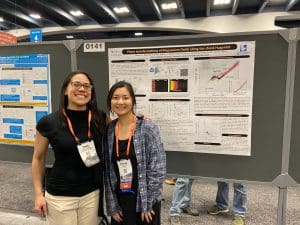
June Wicks will be giving a tutorial talk, “Novel Experiments for Understanding the Interior of the Earth, Planets, and Exoplanets” this Wednesday at the AGU conference. June will cover the advantages, challenges, and future prospects of diamond anvil cell, as well as laser shock compression and ramp compression experiments. She will be speaking on the frontiers of pressure-temperature space now accessible due to recent advancements in experimental arrangements, particularly those of the ramp compression type. These experiments, as well as other dynamic and static compression experiments, provide a window into the structure and behavior of minerals at pressures and temperatures of the deep earth and the interior of larger rocky exoplanets.
TT32D – Novel Experiments for Understanding the Interior of the Earth, Planets, and Exoplanets; Wednesday, Dec. 11. 11:50-12:20; Moscone South, 104-105, LLS
Zixuan Ye, a second year graduate student of Wicks Lab, will present her poster in the session entitled Advances in Ultra-High Pressure Science with Applications to Super-Earths and Giant Planets (session ID# 76333). She will share her and others’ work in developing a phase diagram for magnesium oxide at pressure-temperature regimes at interiors of planets whose mass is 3-5 times greater than that of Earth (at pressures in the range of 300-500 gigapascals). The data from her shock compression experiments plots points along the MGO Hugoniot, which is a curve connecting individual shocked states of a material, showing that material’s change in density to a particular shock-inducing pressure wave. By retrieving the pressures and temperatures achieved in the experiments, and the phase(s) present in the sample, Zixuan is able to continue filling in the phase diagram for this important mineral. It is interesting to note that there is a triple point in the phase diagram adjacent to the Hugoniot, and there are thermal anomalies observed when the crystal orientation is changed.
MR23D-0141 – Phase Transitions of Magnesium Oxide under Shock Compression; Tuesday, Dec. 10. 13:40-18:00; Moscone South, Poster Hall
Come by and see our work, and stay tuned for future developments!
